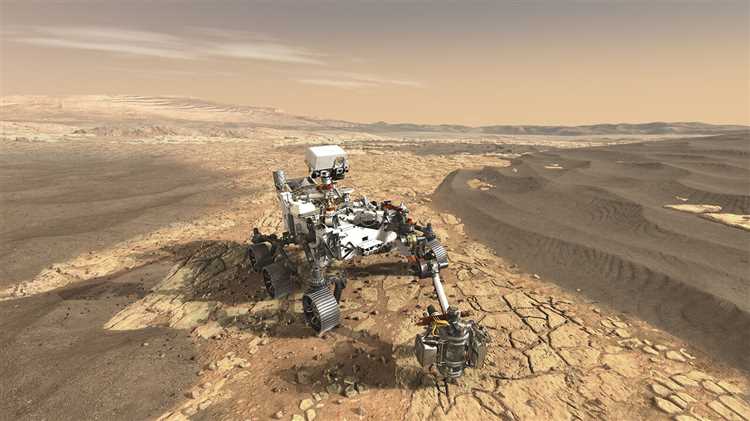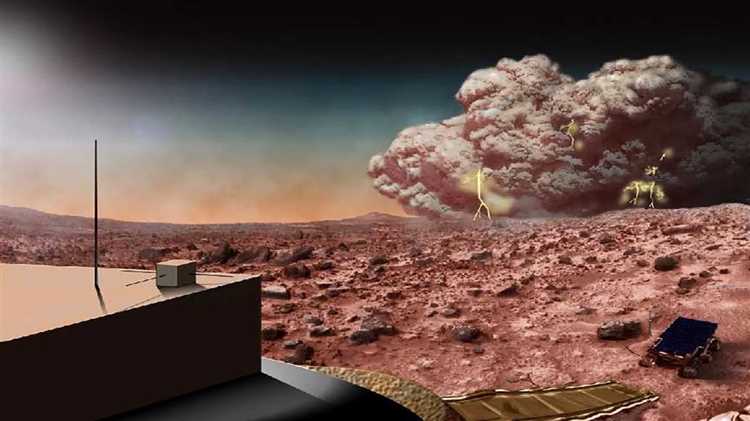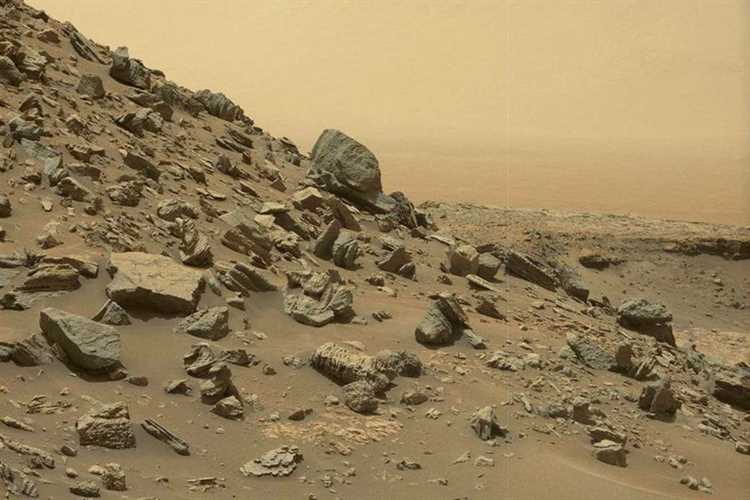
One of the most intriguing questions about Mars is whether it has rain. After all, rain is a fundamental element of life as we know it on Earth. However, due to the harsh conditions on the Red Planet, the presence of rain has long been a topic of debate among scientists.
On Mars, the average temperature is much colder than on Earth, and the atmospheric pressure is about 100 times lower. These factors make it extremely difficult for liquid water to exist on the surface. The thin atmosphere cannot hold on to water vapor, causing it to quickly escape into space. As a result, any rain that might form would likely evaporate before reaching the ground.
Despite these challenges, evidence suggests that Mars may have experienced rain in the past. Scientists have discovered signs of ancient riverbeds and deltas, indicating that liquid water once flowed on the surface. The presence of these features suggests that rain could have played a role in shaping the Martian landscape. However, it is still unclear whether rain currently falls on Mars or if it is limited to occasional storms or seasonal events.
- Overview of Mars Atmosphere
- Composition
- Thickness
- Weather
- Possibility of Rainfall on Mars
- Presence of Water on Mars
- Scientific Studies on Martian Rain
- Future Exploration and Discoveries
- Potential for Life
- Uncovering Mars’ History
- Q&A:
- Can it rain on Mars?
- Why is the atmosphere on Mars so thin?
- What is the weather like on Mars?
- Are there any signs of water on Mars?
- Could there have been rain on Mars in the past?
- Does it rain on Mars?
- Are there any rainstorms on Mars?
Overview of Mars Atmosphere
Mars is the fourth planet from the Sun in our solar system and it has a unique atmosphere compared to other planets. Understanding the atmosphere of Mars is crucial in determining the chances of finding water or rain on the planet.
Composition
The Martian atmosphere is primarily composed of carbon dioxide (CO2) with traces of nitrogen, argon, and oxygen. The levels of carbon dioxide are over 95% in the atmosphere, making the air extremely thin and unbreathable for humans.
Thickness
Compared to Earth’s atmosphere, the Martian atmosphere is only about 1% as thick. This means that the atmospheric pressure on Mars is much lower, and the air is much less dense. As a result, water cannot exist as a liquid on the surface of Mars, but instead, it either freezes or vaporizes.
However, although liquid water is not stable on Mars, there is evidence of water ice on the planet, mostly in the form of polar ice caps and underground ice deposits.
Weather

The weather on Mars is highly variable, with temperature extremes ranging from -195 degrees Fahrenheit (-125 degrees Celsius) near the poles to a high of 70 degrees Fahrenheit (20 degrees Celsius) at the equator during the summer. Mars experiences dust storms that can cover the entire planet, lasting for weeks or even months.
These dust storms can have a significant impact on the planet’s atmospheric conditions and may influence the possibility of rainfall on Mars.
Possibility of Rainfall on Mars
Many scientists have long debated whether or not rain is possible on Mars. Given the planet’s thin atmosphere and cold temperatures, it might seem unlikely that rain could occur. However, recent discoveries and ongoing research suggest that there is a possibility of rainfall on Mars.
One key factor to consider is the presence of water on the planet. While Mars is generally dry, there are signs that liquid water exists, at least in certain regions. The discovery of ancient dried-up riverbeds and the presence of ice caps suggest that there may be water reserves hidden beneath the surface.
Another important consideration is the planet’s atmosphere. While thin, Mars does have an atmosphere that contains traces of carbon dioxide and water vapor. These atmospheric conditions, along with the presence of water, provide the necessary ingredients for potential rain formation.
Researchers have conducted laboratory experiments to shed light on the possibility of rain on Mars. It was found that under certain conditions, water droplets can form and fall from the atmosphere. These droplets, although small and light, could potentially be classified as rain.
However, it is worth noting that any rainfall on Mars would likely be quite different from what we experience on Earth. Due to the planet’s low atmospheric pressure, the raindrops would be smaller and would fall slower than on our planet. Additionally, the low temperatures on Mars would cause the rain to freeze quickly upon hitting the ground.
Overall, while the possibility of rain on Mars is not yet confirmed, scientific evidence suggests that it is not entirely out of the question. Further research and exploration of the Red Planet will be crucial in determining the likelihood and characteristics of rainfall on Mars.
Presence of Water on Mars
Water is one of the essential ingredients for life as we know it, and its presence on Mars has been a topic of great interest among scientists for many years. While the idea of liquid water on the Martian surface may seem far-fetched, recent discoveries have provided compelling evidence for its past existence.
The discovery of hydrated minerals on Mars points to the presence of water in the planet’s history. These minerals, such as hematite, goethite, and clays, form in the presence of water, suggesting that liquid water once flowed on the Martian surface. The presence of these minerals has been confirmed by various Mars rovers and landers over the years.
In addition to hydrated minerals, there is evidence of ancient riverbeds, canyons, and other geological features that strongly indicate the presence of liquid water in Mars’ distant past. These features suggest that Mars may have had a thicker atmosphere in the past, allowing water to exist in a liquid state. However, due to the planet’s thin atmosphere and low atmospheric pressure, liquid water cannot currently exist on the Martian surface.
Instead, water on Mars is believed to exist primarily in the form of ice. The polar ice caps on Mars are made up of a mixture of water ice and carbon dioxide ice, with the northern polar cap being larger and more permanent than the southern one. These ice caps contain a significant amount of water, and there are also vast underground ice deposits detected near the Martian equator.
While liquid water may not be present on the Martian surface today, the evidence for its past existence and the presence of water in other forms give hope to the possibility of finding life on Mars or sustaining future human missions. Understanding the history and current state of water on Mars is crucial in our search for extraterrestrial life and expanding our knowledge of the potential habitability of other planets.
Scientific Studies on Martian Rain
Scientific studies have provided valuable insights into the possibility of rain on Mars. Researchers have been using various instruments and technologies to gather data and analyze atmospheric conditions on the red planet. One of the key areas of study has been the presence of water vapor in the Martian atmosphere, which is essential for the formation of rain.
Data obtained from orbiting spacecraft and rovers on the Martian surface have provided evidence of water vapor in the atmosphere. The presence of water vapor indicates the potential for rain on Mars. However, the atmospheric conditions on Mars are drastically different from those on Earth, with much lower temperatures and atmospheric pressure. This means that rain on Mars would be very different from rain on Earth.
Scientists have also studied the formation of clouds on Mars, as clouds are a precursor to rain. These studies have revealed the presence of cloud formations, including both water ice and dry ice clouds. These clouds can potentially release precipitation in the form of rain or snow, depending on the temperature and other factors.
Another study focused on the evaluation of humidity levels in the Martian atmosphere. By examining changes in humidity over time and in different locations, scientists have gained insights into the likelihood of rain. While the data suggests the possibility of rain in certain regions and seasons, more research is needed to confirm these findings.
Overall, scientific studies on Martian rain have provided valuable information on the potential for precipitation on the red planet. While rain on Mars may not be comparable to rain on Earth, these studies have contributed to our understanding of the Martian atmosphere and its weather patterns. Further research and exploration will continue to shed light on this fascinating topic.
Future Exploration and Discoveries

Exploring Mars has been an ongoing mission for scientists and space agencies around the world. As our knowledge of the Red Planet continues to grow, so does our curiosity and desire to uncover its secrets. With advancements in technology and the increasing interest in space exploration, future missions to Mars hold the potential for exciting discoveries.
Potential for Life
One of the key objectives of future Mars missions is the search for life. Scientists are eager to find evidence of microbial life or indications of past life forms on the planet. The presence of liquid water, the building blocks of life, and the potential for underground ecosystems make Mars an intriguing candidate for hosting life.
Future explorations will involve drilling deeper into the Martian surface, examining soil and rock samples, and analyzing them for signs of organic compounds or other evidence of microbial life. These discoveries could provide invaluable insights into the origins of life in the universe and expand our understanding of the potential habitability of other planets.
Uncovering Mars’ History
Mars is often referred to as a “frozen desert,” but it hasn’t always been this way. Future missions aim to unravel the planet’s past and understand its geological evolution. By studying the Martian landscape, scientists hope to gain a better understanding of the planet’s climate history, the existence of ancient oceans, and the processes that shaped its surface.
Exploration rovers equipped with advanced instruments will continue to map the topography, study the composition of rocks and minerals, and analyze the atmosphere to unravel Mars’ geological history. These findings will not only shed light on the Red Planet but also help scientists understand Earth’s own past and potential future climate changes.
| Future Missions | Launch Date | Objective |
|---|---|---|
| Mars 2020 | 2022 | Collect rock samples for potential return to Earth |
| ExoMars 2022 | 2022 | Search for signs of past or present life |
| Mars Sample Return | 2026 (planned) | Bring back Martian soil and rock samples |
Q&A:
Can it rain on Mars?
No, it cannot rain on Mars. The planet’s atmosphere is too thin, with only about 1% of the density of Earth’s atmosphere.
Why is the atmosphere on Mars so thin?
Mars has a thin atmosphere because it lacks a strong magnetic field to protect it from solar wind. The solar wind has slowly stripped away the planet’s atmosphere over billions of years.
What is the weather like on Mars?
The weather on Mars is generally cold and dry. The average temperature is around -80 degrees Fahrenheit (-62 degrees Celsius), and the air is extremely dry with very low humidity.
Are there any signs of water on Mars?
Yes, there are signs of water on Mars. Scientists have discovered evidence of ancient riverbeds, polar ice caps, and even occasional liquid water flows on the surface.
Could there have been rain on Mars in the past?
It is possible that there was rain on Mars in the past when the planet had a thicker atmosphere and a more hospitable climate. However, the current conditions do not support rain formation.
Does it rain on Mars?
There is no evidence of rain on Mars. The planet has a very thin atmosphere, which makes it difficult for liquid water to exist on the surface. However, there is evidence of past liquid water on Mars, such as ancient riverbeds and polar ice caps.
Are there any rainstorms on Mars?
Rainstorms, as we know them on Earth, do not occur on Mars. The planet’s atmosphere is too thin and cold to support the formation of rain clouds. Instead, Mars experiences dust storms, which can cover the entire planet and last for weeks or even months.